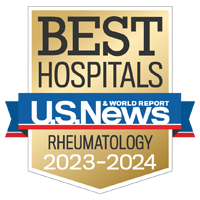Ankylosing Spondylitis

Overview
Ankylosing spondylitis is an inflammatory condition that involves the spine and skeleton of the head and trunk. The disorder causes inflammation and pain in joints in the spine, pelvis and other parts of the skeleton. In addition, parts of the spine, the hips or the sacroiliac joints where the hips join the lower back, may fuse, or grow, together.
Our approach to ankylosing spondylitis
UCSF provides comprehensive evaluations and advanced care for ankylosing spondylitis. We offer the latest diagnostic techniques and strive to identify the disease early using special physical examination methods and magnetic resonance imaging (MRI).
Treatment options include nonsteroidal anti-inflammatory drugs and a class of medications called disease-modifying anti-rheumatic drugs, as well as newer medications that inhibit cytokines, immune system cells that appear to cause some of the symptoms of ankylosing spondylitis. Orthopedic surgery, such as joint replacement and spinal reconstruction, may be an option for patients with severe cases. We also recommend exercise and physical therapy to relieve pain and increase strength and flexibility.
In addition to caring for patients, our team conducts research to improve the understanding and treatment of ankylosing spondylitis. Interested patients may have the option to receive investigational treatments by participating in clinical trials.
Awards & recognition
-

Among the top hospitals in the nation
-

Best in California and No. 7 in the nation for rheumatology
Signs & symptoms
Symptoms of ankylosing spondylitis include:
- Pain
- Stiffness, especially in the morning
- Functional limitation
When the disorder affects the spine, it also may result in progressive deformity including curvature of the back, called kyphosis, and the inability to stand up straight.
Diagnosis
The first clue in diagnosing ankylosing spondylitis is the presence of symptoms, especially back pain. In addition, X-rays are taken to look for signs of the disorder, such as fused joints. A blood test for the HLA-B27 gene, which is found in about 90 percent of the people with ankylosing spondylitis, also may be performed. However, only 10 percent to 15 percent of people who inherit the gene develop ankylosing spondylitis.
Treatments
Ankylosing spondylitis usually is treated with:
- Pain or anti-inflammatory medications
- Antirheumatic drugs
- Exercise
- Physical therapy
Our experts are currently working with new medications that inhibit immune-system cells, called cytokines, which appear to cause some of the symptoms of ankylosing spondylitis.
Joint replacement surgery, most commonly of the hips and shoulders, may be an option for severely affected patients. In addition, spinal reconstruction and internal bracing may be necessary to treat severe spine deformities associated with ankylosing spondylitis.
UCSF Health medical specialists have reviewed this information. It is for educational purposes only and is not intended to replace the advice of your doctor or other health care provider. We encourage you to discuss any questions or concerns you may have with your provider.











